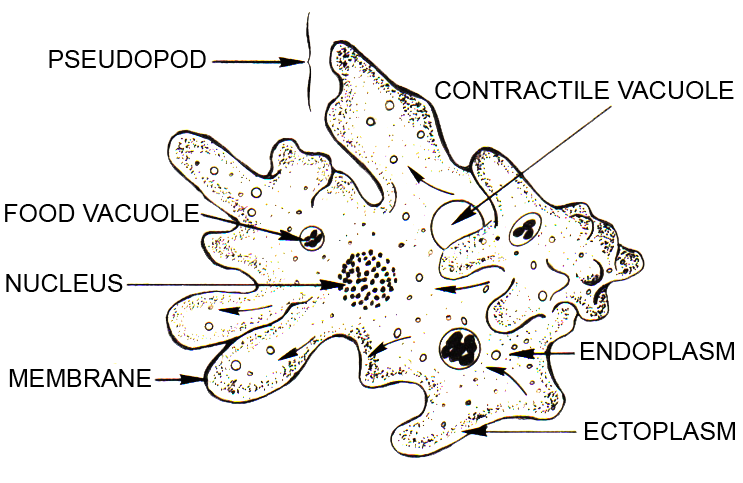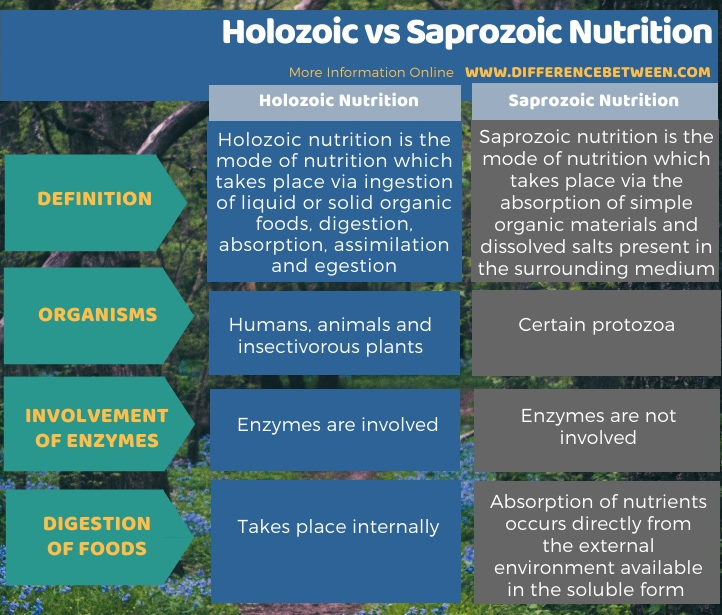Difference Between Holozoic and Saprozoic Nutrition
The key difference between holozoic and saprozoic nutrition is that holozoic nutrition is the mode of nutrition which takes place via ingestion of liquid or solid organic foods, digestion, absorption, assimilation and egestion whereas saprozoic nutrition is the mode of nutrition which takes place via absorption of simple organic materials and dissolved salts present in the surrounding medium.
Nutrition is a requirement of all living organisms for growth, metabolism, and repair. It depends on the source of carbon and the source of energy. Some organisms are able to produce their own foods. They are autotrophs. But, many organisms cannot produce their own foods; hence, they depend on the food produced by the autotrophs. We call these organisms heterotrophic organisms. Based on different sources of carbon and energy, several modes of nutrition can be seen; holozoic and saprozoic nutrition are two types among them.
CONTENTS
1. Overview and Key Difference
2. What is Holozoic Nutrition
3. What is Saprozoic Nutrition
4. Similarities Between Holozoic and Saprozoic Nutrition
5. Side by Side Comparison – Holozoic vs Saprozoic Nutrition in Tabular Form
6. Summary
What is Holozoic Nutrition?
Holozoic nutrition is a mode of nutrition in which solid and complex foods are taken directly into the body. Organisms that show holozoic nutrition contain a complete digestive system. Hence, they can use the food produced by primary producers. Moreover, in this mode of nutrition, organisms use forms of organic carbon to obtain energy. Holozoic nutrition is the mode of nutrition followed by humans, animals, and insectivorous plants.
Holozoic nutrition occurs via five different processes: ingestion, digestion, absorption, assimilation, and egestion. Ingestion is the process of taking food into the body in the form of solid food by higher-level organisms. Once the food is ingested, they undergo digestion. Digestion is the process of transforming complex food into simple food. It takes place in two ways: mechanical digestion and chemical digestion. Different enzymes participate in the chemical digestion process. During the digestion process, carbohydrates are broken down into glucose and lipids are broken down into fatty acids and glycerol. Moreover, proteins are broken down into amino acids. Mechanical digestion takes place in the buccal cavity and the stomach.

In the small intestine, absorption of nutrients such as glucose, amino acids, fatty acids, and glycerol takes place via the microvilli and the lacteals. Water absorption occurs mainly in the large intestines. Various organs, tissues, and cells absorb nutrients during the assimilation process. Finally, through egestion, the body removes undigested foods via the anus to the exterior.
What is Saprozoic Nutrition?
Saprozoic nutrition is defined as a type of nutrition where the animal fulfils its nutrient requirements through the absorption of simple organic materials and dissolved salts present in the surrounding medium. Organisms that use this mode of nutrition are known as saprozoic feeders. Mainly protozoans possess this type of mode of nutrition. Thus, some species of protozoa have the ability to absorb complex organic compounds that are present in a solution through the surface of their bodies under a special type of osmosis process. The unique osmosis process is referred to as osmotrophy.
The basic nutrient requirements of organisms that depend on the saprozoic mode of nutrition are ammonium salts, amino acids, and peptones. The typical saprozoic protozoans include parasitic Monocystis.
What are the Similarities Between Holozoic and Saprozoic Nutrition?
- Holozoic and saprozoic nutrition are two modes of nutrition seen in organisms.
- Both are types of heterotrophic nutrition.
- Protozoans show both holozoic and saprozoic nutrition.
What is the Difference Between Holozoic and Saprozoic Nutrition?
Holozoic nutrition is the mode of nutrition which takes place via ingestion of liquid or solid organic foods, digestion, absorption, assimilation, and egestion. Saprozoic nutrition is a type of nutrition where the animal fulfills its nutrient requirements through the absorption of simple organic materials and dissolved salts present in the surrounding medium. So, this is the key difference between holozoic and saprozoic nutrition. Besides, holozoic nutrition is shown by man and other higher forms of animals while most of the protozoans show a saprozoic mode of nutrition.
The below infographic summarizes the difference between holozoic and saprozoic nutrition.

Summary – Holozoic vs Saprozoic Nutrition
Holozoic and saprozoic are two types of heterotrophic nutritional modes. In holozoic nutrition, organisms ingest solid or liquid organic materials and digest them, absorb nutrients, assimilate nutrients and remove undigested foods via egestion. In saprozoic nutrition, some unicellular protozoans absorb liquid organic substances from their surrounding medium and use them as foods. So, this is the key difference between holozoic and saprozoic nutrition.
Reference:
1. “Definitions for Holozoic Nutritionholo·Zoic Nu·Tri·Tion.” What Does Holozoic Nutrition Mean? Available here.
2. “Nutrition and Protozoa (With Diagram).” Biology Discussion, 2 May 2016, Available here.
Image Courtesy:
1. “Amoeba (PSF)” By Pearson Scott Foresman – Archives of Pearson Scott Foresman, donated to the Wikimedia Foundation (Public Domain) via Commons Wikimedia
ncG1vNJzZmivp6x7pbXFn5yrnZ6YsqOx07CcnqZemLyue8OinZ%2Bdopq7pLGMm5ytr5Wau260zqWms6eZmHqiusNmqpqooqTHsLXCZqWurKKewaq7zWg%3D